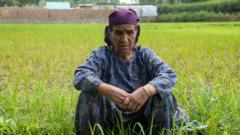The last few months have seen a scorching heatwave hit the picturesque Himalayan region, known traditionally for its cool climate. Experts reported that the summer's extreme heat coupled with erratic rainfall has left many farmers grappling with crop failures. Zaina, who has been unable to harvest healthy paddy crops for the past five years, fears the worst for her family's livelihood. “This summer, it feels like our worst fears have come true,” she expressed, voicing the desperation of many in her community.
This unprecedented heat anomaly has raised alarms among scientists, as data shows a 2C increase in maximum temperatures from 1980 to 2020. Mukhtar Ahmad, a meteorological expert, noted that three separate heatwaves have already been recorded this season, leading to the drying of rivers and streams crucial for irrigation. The environmental signs of crisis are stark, such as wilting apple trees on the farm of Ali Mohammad, who abandoned rice cultivation years ago due to unreliable weather.
The toll isn’t solely agricultural; residents are also bearing the brunt of rising temperatures. Individuals like Parveez Ahmad, aged 63, have experienced severe health issues exacerbated by the relentless heat. “I have never encountered such an intense heatwave in my life,” he shared after a recent hospitalization linked to the weather.
Environmentalists argue that climate change is systematically transforming Kashmir, causing a rise in extreme weather events. Warmer winters and prolonged dry spells are depleting snow cover and disrupting local ecosystems, warned glaciologist Mohammad Farooq Azam. This transformation threatens not just the current livelihood of farmers but puts long-term water security in jeopardy.
Furthermore, the region's limited industrial footprint means it contributes minimally to global carbon emissions; however, it is still feeling the profound effects of global climate shifts. As urbanization expands in Kashmir—rapidly replacing farmlands with concrete structures—the challenge to manage the local climate is exacerbated.
The loss of around 0.39% of tree cover from 2001 to 2023 due to deforestation further complicates the situation. Higher energy demands, driven by urban living and air conditioning needs, create a vicious cycle of rising temperatures and increased greenhouse gas emissions.
Despite the mounting pressures, critics argue that climate-related issues receive scant attention from local policymakers. Jammu and Kashmir's authorities claim to take climate change seriously, but farmers like Zaina are concerned that any necessary interventions must come rapidly. “Otherwise, we will be doomed,” she reiterated, encapsulating the urgency of the crisis in Kashmir, where both health and harves are hanging by a thread.
This unprecedented heat anomaly has raised alarms among scientists, as data shows a 2C increase in maximum temperatures from 1980 to 2020. Mukhtar Ahmad, a meteorological expert, noted that three separate heatwaves have already been recorded this season, leading to the drying of rivers and streams crucial for irrigation. The environmental signs of crisis are stark, such as wilting apple trees on the farm of Ali Mohammad, who abandoned rice cultivation years ago due to unreliable weather.
The toll isn’t solely agricultural; residents are also bearing the brunt of rising temperatures. Individuals like Parveez Ahmad, aged 63, have experienced severe health issues exacerbated by the relentless heat. “I have never encountered such an intense heatwave in my life,” he shared after a recent hospitalization linked to the weather.
Environmentalists argue that climate change is systematically transforming Kashmir, causing a rise in extreme weather events. Warmer winters and prolonged dry spells are depleting snow cover and disrupting local ecosystems, warned glaciologist Mohammad Farooq Azam. This transformation threatens not just the current livelihood of farmers but puts long-term water security in jeopardy.
Furthermore, the region's limited industrial footprint means it contributes minimally to global carbon emissions; however, it is still feeling the profound effects of global climate shifts. As urbanization expands in Kashmir—rapidly replacing farmlands with concrete structures—the challenge to manage the local climate is exacerbated.
The loss of around 0.39% of tree cover from 2001 to 2023 due to deforestation further complicates the situation. Higher energy demands, driven by urban living and air conditioning needs, create a vicious cycle of rising temperatures and increased greenhouse gas emissions.
Despite the mounting pressures, critics argue that climate-related issues receive scant attention from local policymakers. Jammu and Kashmir's authorities claim to take climate change seriously, but farmers like Zaina are concerned that any necessary interventions must come rapidly. “Otherwise, we will be doomed,” she reiterated, encapsulating the urgency of the crisis in Kashmir, where both health and harves are hanging by a thread.


















